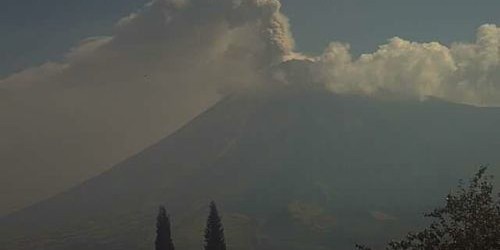

| Visitors Now: | |
| Total Visits: | |
| Total Stories: |
Tungurahua volcano in full eruption volcanic ash over 7 km

Ecuador has issued the second-highest warning level (Orange) for towns near the Tungurahua volcano. After a huge increase in seismicity on December 15, 2012 a strong ash explosion occurred at 14:35 local time.
According to local reports, the eruption produced an ash plume rising to 6 km altitude and was visible from Ambato, Riobamba, Pelileo and Patate. The explosion followed an increase in seismicity over the last two days.
Tongurahua (“Throat of Fire”), about 135 km south of the capital Quito, remains in full vulcanian eruption complete with ashfall, loud roars, pyroclastic flow and plumes of volcanic ash over 7 km at times. (ER)
The area of the warning covers the adjacent provinces of Tungurahua and Chimborazo, according to the national civil defence agency.
Tungurahua, a steep-sided andesitic-dacitic stratovolcano that towers more than 3 km above its northern base, is one of Ecuador’s most active volcanoes. Three major volcanic edifices have been sequentially constructed since the mid-Pleistocene over a basement of metamorphic rocks. Tungurahua II was built within the past 14,000 years following the collapse of the initial edifice. Tungurahua II itself collapsed about 3000 years ago and produced a large debris-avalanche deposit and a horseshoe-shaped caldera open to the west, inside which the modern glacier-capped stratovolcano (Tungurahua III) was constructed.
Historical eruptions have all originated from the summit crater. They have been accompanied by strong explosions and sometimes by pyroclastic flows and lava flows that reached populated areas at the volcano’s base.
Prior to a long-term eruption beginning in 1999 that caused the temporary evacuation of the city of Baños at the foot of the volcano, the last major eruption had occurred from 1916 to 1918, although minor activity continued until 1925 (GVP).
WEBCAMS:
- Volcán Tungurahua – OVT (Guadalupe)
- Volcán Tungurahua – Bayushig
- Volcán Tungurahua – Pillate
- Volcán Tungurahua – Juive
- Volcán Tungurahua – Achupashal
- Volcán Tungurahua – Runtún
- Volcán Tungurahua – Animación de Cámaras
Tungurahua volcano in full eruption – volcanic ash over 7 km
2012-12-17 20:20:59
Source:



